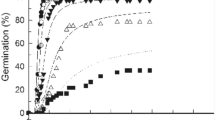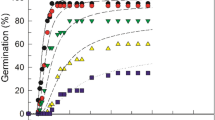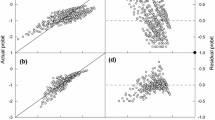Abstract
We quantified the seed germination responses of chicory (Cichorium intybus L.; Asteraceae) to heat, water and salt stresses using hydrothermal time (HTT) and halothermal time (HaloTT) models. We extended the HaloTT model based on NaCl concentration to include supra-optimal temperatures. The HTT and HaloTT models enabled quantitative comparison of the effects of reduced water potentials and increased salinity on germination. Below 30 °C, the median threshold water potential permitting germination estimated by the HTT model (− 0.83 MPa) was higher than that estimated by the HaloTT model (− 1.30 MPa, after converting the median threshold NaCl concentration to osmotic potential). Ion uptake into seeds imbibed in salt solutions accounted for an average osmotic adjustment of 36% in the presence of salt stress compared to seeds imbibed in polyethylene glycol solutions. These thresholds became more positive above 30 °C with a common median ceiling temperature of 43 °C. The HaloTT models developed here accurately described germination responses to NaCl concentrations across all temperatures and incorporated both water potential and osmotic adjustment effects. With respect to seed germination, chicory could be considered as a moderately water stress tolerant species and highly tolerant to salt stress.






Similar content being viewed by others
Abbreviations
- Cl– :
-
Chloride ion
- GP:
-
Germination percentage
- GR:
-
Germination rate, or 1/tg
- HaloTT:
-
Halothermal time model
- HTT:
-
Hydrothermal time model
- k T :
-
The slope of the relationship between ψb(50) and/or NaClb(50) and T above To
- M:
-
Molar
- MPa:
-
Megapascal
- Na+ :
-
Sodium ion
- NaCl:
-
NaCl concentration (M)
- NaClb(50):
-
The base NaCl of the 50th percentile
- NaClb :
-
Median base NaCl concentration
- OAV:
-
Osmotic adjustment value
- SG:
-
Seed germination
- SMC:
-
Seed moisture content
- T :
-
Temperature
- T b :
-
Minimum temperature (base temperature)
- T c :
-
Maximum temperature (ceiling temperature)
- T d :
-
The temperature at which ψb(50) and/or NaClb(50) trend begins to change
- t g :
-
The time required for fraction or percentage (g) of seeds to germinate
- T o :
-
Optimum temperature
- θ H :
-
Hydrotime constant
- θ Halo :
-
Halotime constant
- σ NaClb :
-
Standard deviation of NaClb within the seed population
- σψ b :
-
Standard deviation of ψb within the seed population
- ψ :
-
Water potential
- ψb(50):
-
The base ψ of the 50th percentile
- ψ b :
-
Base water potential
References
Abbas ZK, Saggu S, Sakeran MI, Zidan N, Rehman H, Ansari AA (2015) Phytochemical, antioxidant and mineral composition of hydroalcoholic extract of chicory (Cichorium intybus L.) leaves. Saudi J Biol. Sci. 22:322–326
Abdellaoui R, Boughalleb F, Zayoud D, Neffati M, Bakhshandeh E (2019) Quantification of Retama raetam seed germination response to temperature and water potential using hydrothermal time concept. Environ Exp Bot 157:211–216
Alvarado V, Bradford K (2002) A hydrothermal time model explains the cardinal temperatures for seed germination. Plant Cell Environ 25:1061–1069
Arnold S, Kailichova Y, Baumgartl T (2014) Germination of Acacia harpophylla (Brigalow) seeds in relation to soil water potential: implications for rehabilitation of a threatened ecosystem. PeerJ 2:e268
Atashi S, Bakhshandeh E, Zeinali Z, Yassari E, Teixeira da Silva JA (2014) Modeling seed germination in Melisa officinalis L. in response to temperature and water potential. Acta Physiol Plant 36:605–611
Atashi S, Bakhshandeh E, Mehdipour M, Jamali M, Teixeira da Silva JA (2015) Application of a hydrothermal time seed germination model using the Weibull distribution to describe base water potential in zucchini (Cucurbita pepo L.). J Plant Growth Regul 34:150–157
Bakhshandeh E, Gholamhossieni M (2018) Quantification of soybean seed germination response to seed deterioration under PEG-induced water stress using hydrotime concept. Acta Physiol Plant 40:126
Bakhshandeh E, Gholamhossieni M (2019) Modelling the effects of water stress and temperature on seed germination of radish and cantaloupe. J Plant Growth Regul. https://doi.org/10.1007/s00344-00019-09942-00349
Bakhshandeh E, Jamali M (2020) Population-based threshold models: a reliable tool for describing aged seeds response of rapeseed under salinity and water stress. Environ Exp Bot. https://doi.org/10.1016/j.envexpbot.2020.104077
Bakhshandeh E, Atashi S, Hafez-Nia M, Pirdashti H (2013) Quantification of the response of germination rate to temperature in sesame (Sesamum indicum). Seed Sci Technol 41:469–473
Bakhshandeh E, Atashi S, Hafeznia M, Pirdashti H, Teixeira da Silva JA (2015) Hydrothermal time analysis of watermelon (Citrullus vulgaris cv ‘Crimson sweet’) seed germination. Acta Physiol Plant 37:1738
Bakhshandeh E, Jamali M, Afshoon E, Gholamhossieni M (2017) Using hydrothermal time concept to describe sesame (Sesamum indicum L.) seed germination response to temperature and water potential. Acta Physiol Plant 39:250
Bakhshandeh E, Pirdashti H, Vahabinia F, Gholamhossieni M (2019) Quantification of the effect of environmental factors on seed germination and seedling growth of Eruca (Eruca sativa) using mathematical models. J Plant Growth Regul. https://doi.org/10.1007/s00344-00019-09974-00341
Bakhshandeh E, Gholamhosseini M, Yaghoubian Y, Pirdashti H (2020) Plant growth promoting microorganisms can improve germination, seedling growth and potassium uptake of soybean under drought and salt stress. Plant Growth Regul 90:123–136
Balandary A, Rezvani Moghaddam P, Nasiri Mahalati M (2011) Determination of seed germination cardinal temperatures in short chicory (Cichorium pumilum Jacq.). Second National Seed Technology Conference, Mashhad, pp 1818–1822
Baskin CC, Baskin JM (2014) Seeds: ecology, biogeography, and evolution of dormancy and germination. Academic, San Diego, p 1600
Bello P, Bradford KJ (2016) Single-seed oxygen consumption measurements and population-based threshold models link respiration and germination rates under diverse conditions. Seed Sci Res 26:199–221
Benítez G, González-Tejero M, Molero-Mesa J (2010) Pharmaceutical ethnobotany in the western part of Granada province (southern Spain): ethnopharmacological synthesis. J Ethnopharmacol 129:87–105
Bewley JD, Bradford K, Hilhorst H, Nonogaki H (2013) Seeds: physiology of development, germination and dormancy, 3rd edn. Springer, New York
Bierhuizen J, Wagenvoort W (1974) Some aspects of seed germination in vegetables. 1. The determination and application of heat sums and minimum temperature for germination. Sci Hortic 2:213–219
Bradford KJ (1986) Manipulation of seed water relations via osmotic priming to improve germination under stress conditions. HortScience 21:1105–1112
Bradford KJ (1990) A water relations analysis of seed germination rates. Plant Physiol 94:840–849
Bradford KJ (1995) Water relations in seed germination. Seed Dev Germ 1:351–396
Bradford KJ (2002) Applications of hydrothermal time to quantifying and modeling seed germination and dormancy. Weed Sci 50:248–260
Bradford KJ, Still DW (2004) Applications of hydrotime analysis in seed testing. Seed Technol 26:75–85
Corbineau F, Come D (1989) Germinability and quality of Cichorium intybus L. seeds. VI Symp Timing Field Prod Veg 267:183–190
Dahal P, Bradford KJ (1994) Hydrothermal time analysis of tomato seed germination at suboptimal temperature and reduced water potential. Seed Sci Res 4:71–80
Estefan G, Sommer R, Ryan J (2013) Methods of soil, plant, and water analysis. A manual for the West Asia and North Africa region, International Center for Agricultural Research in the Dry Areas (ICARDA), p 244
Farzaneh S, Soltani E, Zeinali E, Ghaderi-Far F (2014) Screening oilseed rape germination for thermotolerance using a laboratory-based method. Seed Technol 15–27
Ghaderi-Far F, Bakhshandeh E, Ghadirian R (2010) Evaluating seed quality in sesame (Sesamum indicum L.) by the accelerated ageing test. Seed Technol 32:69–72
Guarrera P, Savo V (2016) Wild food plants used in traditional vegetable mixtures in Italy. J Ethnopharmacol 185:202–234
Gummerson R (1986) The effect of constant temperatures and osmotic potentials on the germination of sugar beet. J Exp Bot 37:729–741
Hatfield JL, Prueger JH (2015) Temperature extremes: effect on plant growth and development. Weather Clim Extrem 10:4–10
Heshmat O, Saeed H, Fardin K (2011) The improvement of seed germination traits in canola (Brassica napus L.) as affected by saline and drought stress. J Agric Sci Technol 7:611–622
Huarte R (2006) Hydrotime analysis of the effect of fluctuating temperatures on seed germination in several non-cultivated species. Seed Sci Technol 34:533–547
International Seed Testing Association (ISTA) (2018) International rules for seed testing. Seed Science and Technology, Zurich
Jouad H, Haloui M, Rhiouani H, El Hilaly J, Eddouks M (2001) Ethnobotanical survey of medicinal plants used for the treatment of diabetes, cardiac and renal diseases in the North centre region of Morocco (Fez–Boulemane). J Ethnopharmacol 77:175–182
Kamkar B, Al-Alahmadi MJ, Mahdavi-Damghani A, Villalobos FJ (2012) Quantification of the cardinal temperatures and thermal time requirement of opium poppy (Papaver somniferum L.) seeds to germinate using non-linear regression models. Ind Crops Prod 35:192–198
Khajeh-Hosseini M, Powell A, Bingham I (2003) The interaction between salinity stress and seed vigour during germination of soyabean seeds. Seed Sci Technol 31:715–725
Khan M, Weber D, Hess W (1985) Elemental distribution in seeds of the halophytes Salicornia pacifica var. utahensis and Atriplex canescens. Am J Bot 72:1672–1675
Liu S, Bradford KJ, Huang Z, Venable DL (2020) Hydrothermal sensitivities of seed populations underlie fluctuations of dormancy states in an annual plant community. Ecology 101(3):e02958
Llanes A, Andrade A, Masciarelli O, Alemano S, Luna V (2016) Drought and salinity alter endogenous hormonal profiles at the seed germination phase. Seed Sci Res 26:1–13
Luan Z, Xiao M, Zhou D, Zhang H, Tian Y, Wu Y, Guan B, Song Y (2014) Effects of salinity, temperature, and polyethylene glycol on the seed germination of sunflower (Helianthus annuus L.). Sci World J 2014:170418. https://doi.org/10.1155/2014/170418
Mesgaran M, Mashhadi H, Alizadeh H, Hunt J, Young K, Cousens R (2013) Importance of distribution function selection for hydrothermal time models of seed germination. Weed Res 53:89–101
Mesgaran MB, Onofri A, Mashhadi HR, Cousens RD (2017) Water availability shifts the optimal temperatures for seed germination: a modelling approach. Ecol Model 351:87–95
Michel BE, Radcliffe D (1995) A computer program relating solute potential to solution composition for five solutes. Agron J 87:126–130
Mobli A, Ghanbari A, Rastgoo M (2018) Determination of cardinal temperatures of Flax-leaf Alyssum (Alyssum linifolium) in response to salinity, pH, and drought stress. Weed Sci 66:470–476
Moltchanova E, Sharifiamina S, Moot DJ, Shayanfar A, Bloomberg M (2020) Comparison of three different statistical approaches (non-linear least-squares regression, survival analysis and Bayesian inference) in their usefulness for estimating hydrothermal time models of seed germination. Seed Sci Res. https://doi.org/10.1017/S0960258520000082
Moot D, Scott W, Roy A, Nicholls A (2000) Base temperature and thermal time requirements for germination and emergence of temperate pasture species. New Zealand J Agric Res 43:15–25
Nobel PS (1983) Biophysical plant physiology and ecology. W. H. Freeman and Co., San Francisco
Parihar P, Singh S, Singh R, Singh VP, Prasad SM (2015) Effect of salinity stress on plants and its tolerance strategies: a review. Environ Sci Pollut Res 22:4056–4075
Parmoon G, Moosavi SA, Siadat SA (2018) How salinity stress influences the thermal time requirements of seed germination in Silybum marianum and Calendula officinalis. Acta Physiol Plant 40:175
Rowse H, Finch-Savage W (2003) Hydrothermal threshold models can describe the germination response of carrot (Daucus carota) and onion (Allium cepa) seed populations across both sub-and supra-optimal temperatures. New Phytol 158:101–108
Sampaio FC, Maria do Socorro VP, Dias CS, Costa VCO, Conde NC, Buzalaf MA (2009) In vitro antimicrobial activity of Caesalpinia ferrea Martius fruits against oral pathogens. J Ethnopharmacol 124:289–294
SAS Institute Inc (2015) SAS/STAT user’s guide. SAS Institute Inc., Cary
Seal CE, Barwell LJ, Flowers TJ, Wade EM, Pritchard HW (2018) Seed germination niche of the halophyte Suaeda maritima to combined salinity and temperature is characterised by a halothermal time model. Environ Exp Bot 155:177–184
Shaygan M, Baumgartl T, Arnold S (2017) Germination of Atriplex halimus seeds under salinity and water stress. Ecol Eng 102:636–640
Song J, Feng G, Tian C, Zhang F (2005) Strategies for adaptation of Suaeda physophora, Haloxylon ammodendron and Haloxylon persicum to a saline environment during seed-germination stage. Ann Bot 96:399–405
Tilaki GAD, Behtari B, Behtari B (2009) Effect of salt and water stress on the germination of alfalfa (Medicago sativa L.) seed. Пoвoлжcкий экoлoгичecкий жypнaл, 158–164
Vahabinia F, Pirdashti H, Bakhshandeh E (2019) Environmental factors’ effect on seed germination and seedling growth of chicory (Cichorium intybus L.) as an important medicinal plant. Acta Physiol Plant 41:27
Van’t Hoff JH (1887) The role of osmotic pressure in the analogy between solutions and gases. Zeitschrift fur physikalische Chemie 1:481–508
Wang R, Bai Y, Tanino K (2005) Germination of winterfat (Eurotia lanata (Pursh) Moq.) seeds at reduced water potentials: testing assumptions of hydrothermal time model. Environ Exp Bot 53:49–63
Yoo S, Murata R, Duarte S (2011) Antimicrobial traits of tea-and cranberry-derived polyphenols against Streptococcus mutans. Caries Res 45:327–335
Zarghani H, Mijani S, Nasrabadi SE (2014) Temperature effects on the seed germination of some perennial and annual species of Asteraceae family. Plant Breed Seed Sci 69:3–14
Zhang H, Irving LJ, McGill C, Matthew C, Zhou D, Kemp P (2010) The effects of salinity and osmotic stress on barley germination rate: sodium as an osmotic regulator. Ann Bot 106:1027–1035
Zhang H, Irving L, Tian Y, Zhou D (2012) Influence of salinity and temperature on seed germination rate and the hydrotime model parameters for the halophyte, Chloris virgata, and the glycophyte, Digitaria sanguinalis. South Afr J Bot 78:203–210
Acknowledgements
This work is financially supported by the Genetics and Agricultural Biotechnology Institute of Tabarestan (GABIT) and Sari Agricultural Sciences and Natural Resources University (SANRU) research Grant (D.2169.97.31). We also gratefully acknowledge use of the services and facilities of the GABIT during this research.
Author information
Authors and Affiliations
Corresponding author
Ethics declarations
Conflict of interest
The authors declare no conflicts of interest.
Additional information
Communicated by S. Renault.
Publisher's Note
Springer Nature remains neutral with regard to jurisdictional claims in published maps and institutional affiliations.
Rights and permissions
About this article
Cite this article
Bakhshandeh, E., Bradford, K.J., Pirdashti, H. et al. A new halothermal time model describes seed germination responses to salinity across both sub- and supra-optimal temperatures. Acta Physiol Plant 42, 137 (2020). https://doi.org/10.1007/s11738-020-03126-9
Received:
Revised:
Accepted:
Published:
DOI: https://doi.org/10.1007/s11738-020-03126-9




